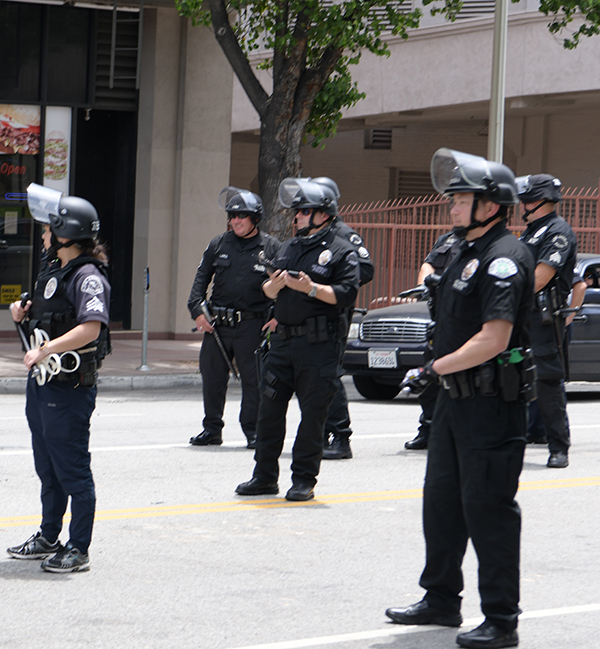By Earl Ofari Hutchinson
Contributing Columnist
There really was no surprise at the recent report issued by the Los Angeles Police Department’s Critical Incident Review Division on the 2023 use of deadly force incidents by the department. The numbers were up.
Put bluntly, the LAPD resorted to more gun play in 2023 than 2022. Or put it in even more stark and deadly terms, more civilians were slain by the LAPD than in the prior year.
Almost certainly some, if not most, of these shootings were questionable. That means that in more than a few cases it was highly questionable how much real danger the alleged suspect posed to an officer that required deadly force.
This is not mere speculation or second guessing. The report gave a strong hint of the answer to that question.
It noted that a significant number of the shootings involved individuals “perceived to suffer from a mental illness or mental health crisis.” That certainly doesn’t describe someone who is engaged in major armed robbery, murder, rape or some other deadly crime that would lend itself to an officer using deadly force.
The deadly force report is even more alarming because it was set against the backdrop of another report released the same week that showed the number of police shootings soared to a record level in 2023. In other words, police officers, be it in Los Angeles or other police departments nationally, shot more persons than ever. As with the LAPD, many of the shootings were very dubious.
There have been countless reports, recommendations, rule changes, investigations, civilian checks and balances on the LAPD, as well as Black Live Matter protests. The latest report on the department’s use of force makes it appear as if none of these things ever happened or meant little to nothing.
Even when the LAPD shot fewer people, the death toll from the shootings has remained high.
The LAPD shootings come in the wake of historic legislation the state Legislature that took effect Jan. 1, 2020. It mandated strict training, accountability and discipline procedures for the use of force by officers. Since the law was passed, however, the number of shootings has remained outrageously high.
So, the question again in the latest LAPD report is did the alleged suspect have to die? The stock answer is that whenever a suspect poses a direct threat to an officer, or an officer responds to a potentially life-threatening incident, he or she can use whatever force is necessary up to and including deadly force.
In more cases than not, this is a strictly subjective judgment call. In almost all cases, officers who use lethal force are shielded from prosecution in the absence of iron-clad proof of wrongdoing. No LAPD officer has been prosecuted for the use of deadly force on duty no matter how questionable in many years.
A prosecution must leap a mountainous bar. That requires the testimony of another officer, a body or dash cam recording, or a preponderance of consistent testimony from civilian eyewitnesses that the killing was unjustified. Even then the victim must have been unarmed, and in most cases not in the commission of a crime.
But what if the victim is armed with a knife, stick, screwdriver or any other non-firearm weapon? And the victim is a woman and suffers from mental or emotional challenges?
The LAPD and other police departments have long grappled with these thorny questions. There is no one size that fits all answer.
Police departments have an array of non-lethal weapons that include bean bags, tasers, stun guns, rubber and wooden bullets, pepper spray and of course, shouts, commands, and attempts to talk down a suspect. But, in the event of any sudden movement toward an officer, all bets are off.
There are many cases where officers have subdued a suspect who has directly confronted an officer with a knife or other potentially lethal weapon without firing a shot and without incurring injury to themselves or the suspect. While the use of force levels will, even in the best-case situations remain a judgment call, there still must be clear policy guidelines that spell out the likely situations in which non-lethal force can and must be used.
There are court rulings that give solid guidance on this. One is the Supreme Court decision in 1985 that forbids police officers from shooting a fleeing person unless the individual poses a significant physical threat to the officer. In all such cases where there is no threat, the officer must use and continue to use non-lethal force. In foot chases, officers have options to call for back-up, employ aerial surveillance and cordon off a perimeter.
A sweeping National Institute of Justice study in 2011 on the use of non-lethal force found that injuries to officers and suspects markedly decreased with the use of non-lethal devices from tasers to pepper spray. It also recommended that good policies and training requirements that officers evaluate the age, size, sex, apparent physical capabilities and health concerns of a suspect in determining what level and type of force to be used.
The LAPD use of deadly force must be drastically reduced. LAPD officials and the L.A. Police Commission must take an even harder look at when, on whom, and in what circumstances non-lethal force should be used.
This is not just a matter of life and death. It’s also a matter of good public and police policy. The public deserves no less.
Earl Ofari Hutchinson is an author and political analyst. The new YouTube documentary American Journalist chronicles his decades long writing and activism. He also is the host of the weekly Hutchinson Report on KPFK 90.7 FM Los Angeles and the Pacifica Network.












